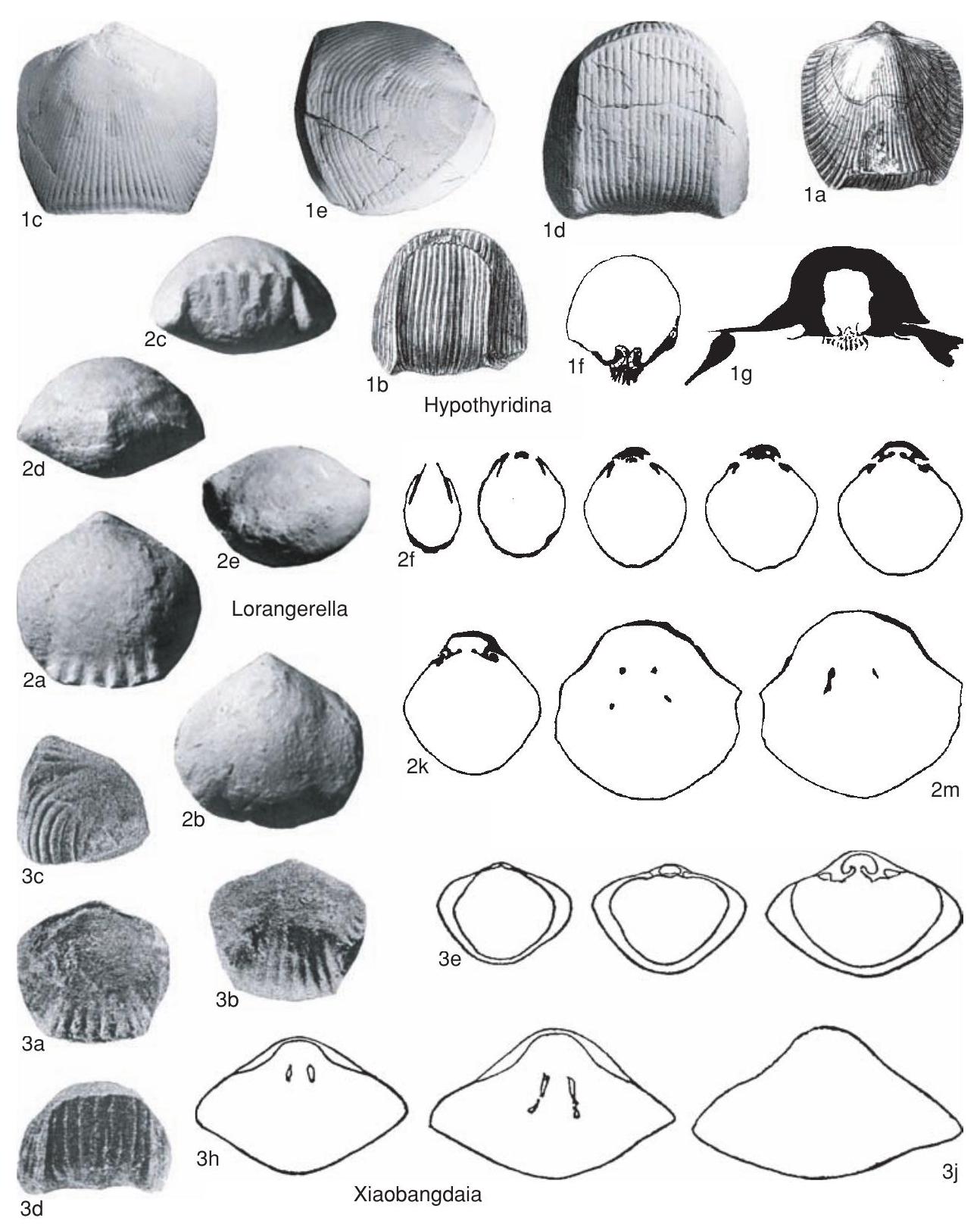Welcome to the Treatise on Invertebrate Paleontology!
Please enter a genera name to retrieve more information.

Hypothyridina
Classification
Phylum:
Brachiopoda
Subphylum:
Rhynchonelliformea
Class:
Rhynchonellata
Order:
Rhynchonellida
Superfamily:
Uncinuloidea
Family:
Hypothyridinidae
Formal Genus Name and Reference:
Hypothyridina Buckman, 1906, p. 324, nom. nov. pro Hypothyris Phillips, 1841, p. 55, non Hubner, 1821
Type Species:
Atrypa cuboides Sowerby, 1840a, pl. 56, fig. 24, SD KING, 1846, p. 28
Images
(Click to enlarge in a new window)
Fig. 765, 1a-e. * H. cuboides (Sowerby), a-b, dorsal and anterior views, Givetian, Plymouth Limestone, Plymouth, England, × 1 (Sowerby, 1840a), c-e, dorsal, anterior, and lateral views, Frasnian, Philippeville, Belgium, specimen 67298, Smithsonian, × 1 (new)., Fig. 765, 1f-g. H. sp. cf. H. impleta (Sowerby), Upper Devonian, Langennaubach, Germany, transverse sections of different young specimens, × 7 (Schmidt, 1965b).
Synonyms
Geographic Distribution
cosmopolitan
Age Range
Beginning Stage in Treatise Usage:
Middle Devonian (Eifelian)
Beginning International Stage:
Eifelian
Fraction Up In Beginning Stage:
0
Beginning Date:
394.3
Ending Stage in Treatise Usage:
Upper Devonian (Famennian)
Ending International Stage:
Famennian
Fraction Up In Ending Stage:
100
Ending Date:
359.3
Description
Medium to large with subcircular to subrectangular outline, strongly biconvex to inflated, lateral and anterior margins very steep. Beak suberect to erect, foramen small, circular, usually obscured by inflated dorsal umbo. Fold and sulcus weak, tongue very high, rectangular to rounded. Costae numerous, evenly developed, simple, flattened on paries geniculatus, marginal spines present. Dental plates short, subvertical to vertical. Dorsal median septum and septalium weak to absent, hinge plates short, horizontal, divided, or sometimes united by cardinal process, cardinal process usually short, with several lobes.
References
Museum or Author Information
Classification
Phylum:
Brachiopoda
Subphylum:
Rhynchonelliformea
Class:
Rhynchonellata
Order:
Rhynchonellida
Superfamily:
Uncinuloidea
Family:
Hypothyridinidae
Formal Genus Name and Reference:
Hypothyridina Buckman, 1906, p. 324, nom. nov. pro Hypothyris Phillips, 1841, p. 55, non Hubner, 1821
Type Species:
Atrypa cuboides Sowerby, 1840a, pl. 56, fig. 24, SD KING, 1846, p. 28
Images
(Click to enlarge in a new window)
Fig. 765, 1a-e. * H. cuboides (Sowerby), a-b, dorsal and anterior views, Givetian, Plymouth Limestone, Plymouth, England, × 1 (Sowerby, 1840a), c-e, dorsal, anterior, and lateral views, Frasnian, Philippeville, Belgium, specimen 67298, Smithsonian, × 1 (new)., Fig. 765, 1f-g. H. sp. cf. H. impleta (Sowerby), Upper Devonian, Langennaubach, Germany, transverse sections of different young specimens, × 7 (Schmidt, 1965b).
Synonyms
Geographic Distribution
cosmopolitan
Age Range
Beginning Stage in Treatise Usage:
Middle Devonian (Eifelian)
Beginning International Stage:
Eifelian
Fraction Up In Beginning Stage:
0
Beginning Date:
394.3
Ending Stage in Treatise Usage:
Upper Devonian (Famennian)
Ending International Stage:
Famennian
Fraction Up In Ending Stage:
100
Ending Date:
359.3
Description
Medium to large with subcircular to subrectangular outline, strongly biconvex to inflated, lateral and anterior margins very steep. Beak suberect to erect, foramen small, circular, usually obscured by inflated dorsal umbo. Fold and sulcus weak, tongue very high, rectangular to rounded. Costae numerous, evenly developed, simple, flattened on paries geniculatus, marginal spines present. Dental plates short, subvertical to vertical. Dorsal median septum and septalium weak to absent, hinge plates short, horizontal, divided, or sometimes united by cardinal process, cardinal process usually short, with several lobes.
